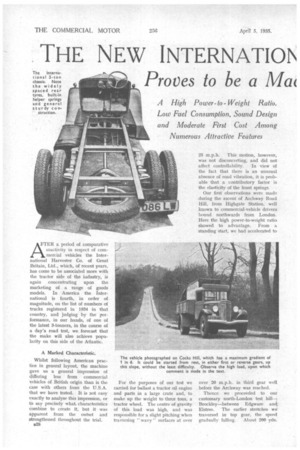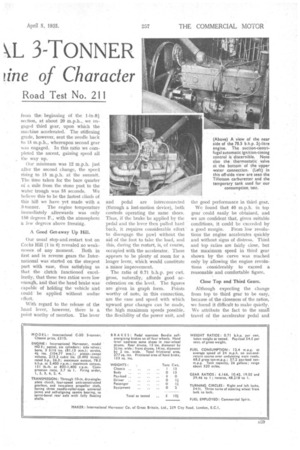THE NEW INTERNATION 3-TONNER
Page 46

Page 47

Page 48

If you've noticed an error in this article please click here to report it so we can fix it.
Proves to be a Ma( tine of Character
AFTER a period of comparative inactivity in respect of commercial vehicles the International Harvester Co. of Great Britain, Ltd., which, of recent years, has come to be associated more with the tractor side of the industry, is again concentrating upon the marketing of a range of goods models. In America the International is fourth, in order of magnitude, on the list of numbers of trucks registered in 1934 in that country, and judging by the performance, in our hands, of one of the latest 3-tonners, in the course of a day's road test, we forecast that the make will also achieve popularity on this side of the Atlantic.
A Marked Characteristic.
Whilst following American practice in general layout, the machine gave us a general impression of differing less from commercial vehicles of British origin than is the case with others from the U.S.A. that we have tested. It is not easy exactly to analyse this impression, or to say precisely what. characteristics combine to create it, but it was apparent from the outset and strengthened throughout the trial. For the purposes of our test we carried for ballast a tractor oil engine and parts in a large crate and, to make up the weight to three tons, a tractor wheel. The centre of gravity of this load was high, and was responsible for a slight pitching when traversing " wavy " surfaces at over 25 m.p.h. This motion, however, was not disconcerting, and did not affect controllability. In view of the fact that there is an unusual absence of road vibration, it is probable that a contributory factor is the elasticity of the front springs.
Our first observations were made during the ascent of Atchway Road Hill, from Highgate Station, well known to commercial-vehicle drivers bound northwards from London. Here the high power-to-weight ratio showed to advantage. From a standing start, we had accelerated to over 20 m.p.h. in third gear well before the Archway was reached. Thence we proceeded to our customary north-London test
hillBrockley—between Edgware and_ Elstree. The earlier stretches we traversed in top gear, the speed
gradually falling. About 200 yds.
from the beginning of the 1-in-81 section, at about 20 M.p.h.,. we engaged third -gear, upon which the machine accelerated. The stiffening grade, however, sent the needle back to 15 m.p.h., whereupon second gear was engaged. In this ratio we completed the ascent, gaining speed all the way up; Our minimum was 12 m.p.h. just after the second change, the speed rising to 15 m.p.h. at the summit. The time taken for the bare quarter of a mile from the stone post. to the water trough was 55 seconds. We believe this to be the fastest climb of this hill we have yet made with a 3-tonner. The engine temperature immediately afterwards was only 150 degrees F. with the atmosphere a few degrees above freezing.
A Good Get-away Up Hill.
Our. usual stop-and-restart test on Cocks Hill (1 in 6) revealed no weaknesses of any moment. Both in first and in reverse gears the .International was started on the steepest part with -ease, thus satisfying us that the clutch functioned excellently, that these two ratios were low enough, and that-the hand brake was capable of holding the vehicleand Could: be applied without undue effort.
With regard to the release of the hand lever, however, there is a point worthy of mention. The lever
and pedal are interconnected (through a lost-motion device), both controls operating the same shoes. Thus, if the brake. be applied by the pedal and the lever then pulled hard back, it requires considerable effort to disengage the pawl without the aid of the foot to take the load, and this, during the restart, is, of course, occupied with the accelerator. There appears to be plenty of room for a longer lever, which would constitute a minor improvement.
. The ratio of 0.71 b.h.p. per cwt. gross, naturally, affords good acceleration on the level. The figures are given in graph form. Points worthy of note, in this connection, are the ease and speed with which upward gear changes can be made, the high maximum speeds possible, the flexibility of the power unit, and
the good performance in third. gear.
We found that 40 m.p.h. in top gear 'could easily be obtained, and we are confident that, given suitable conditions, it could be exceeded by a good margin. From low revolutions the engine accelerates quickly and without signs of distress. Third and top ratios are fairly close, but the maximum speed in third gear shown by the curve was reached only by allowing the engine revolutions considerably to exceed a reasonable and comfortable figure.
Close Top and Third Gears.
Although expecting the change from top to third gear to be easy, because of the closeness of the ratios, we found it difficult to make quietly. We attribute the fact to the small travel of the accelerator pedal and its rather heavy return spring. It is probably merely a matter of knack, and the demonstrator who accompanied us appeared to experience no difficulty.
All three pedals and both levers are not quite so light to operate as is nowadays generally the case on machines in the same class as this International. Nevertheless, there is not the least justification for criticism of the clutch, foot brake or gear controls.
With regard to the steering, this is as light as, if not lighter than, the average and, whilst having little self-centring action, is precise and steady. The lightness diminishes, with a fall of speed, less than usually, and, in the extreme case, with the vehicle stationary, the front road wheels can be moved from lock to lock without straining unmercifully at the steering wheel. The practical value of this point is found when manceuvring or turning sharp corners at a walking pace, and the value is real.
An accurate and iepresentative fuel-consumption test was carried out over a distance of 24.8 miles, a test tank being employed for the purpose and two gallons being consumed. Starting from the junction of the North Orbital road and the Barnet By-pass, we followed the main road to Welwyn, there branching off through Codicote towards Hitchin. At the end of 12.3 miles one gallon had been used. We then retraced our tracks, reaching a point 0.2 mile beyond the starting point on the second gallon.
Demonstrations of the ability of the engine to "hang on" when climbing were afforded on the long ascent by Welwyn Garden City, which was accomplished in top gear. 18 m.p.h. being the minimum speed, and on Digswell Hill during the return journey, which we climbed at 20 m.p.h., whilst the steep hill out of Welwyn Village. travelling southwards, just necessitated second gear, a30 in which ratio the acclivity was easily climbed at about 12 m.p.h.
No mean part in the performance of the engine is played, we surmise, by the automatic ignition-timing control, which combines a centrifugally and suction-operated advance and retard mechanism. Another device deserving mention in this connection is the "pump accelerator," incorporated in the Tillotson carburetter, which temporarily enriches the mixture on sudden throttle openings. The strangler of this instrument, incidentally, is provided with relief valves to prevent choking through misuse when starting up.
When setting off after our lunch stop, during which the engine had cooled right down, we observed that it had reached its running tempera ture within less than half a mile. This is due to the use of a thermostatic valve at the cylinder-head water outlet, and, according to modern theories, should retard .cylinder wear.
Three points, that will serve as examples of the care taken by the designers to facilitate maintenance, are the self-adjusting ball joints in the steering linkage, the provision for lubrication of the clutchwithdrawal bearing without lifting the floorboards, and the means for injecting oil to the clutch spigot.
An inspection of the chassis reveals numerous other desirable features, incorporated to ensure good perform ance, long life and easy maintenance. Moreover, the finish of the 'machine is good and its lines are distinctive.
Keen as is the competition among makers of chassis for pay-loads in the neighbourhood of 3 tons, the price, at which this International is offered, places it at least on a level with its rivals.




































































































